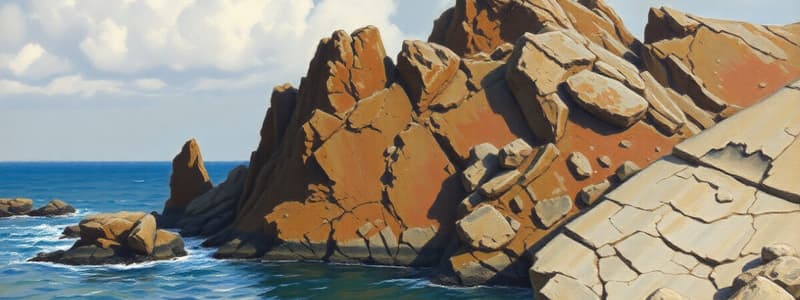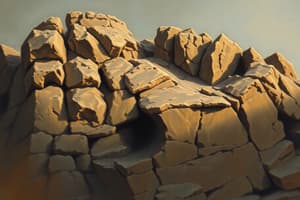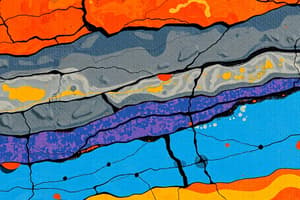Podcast
Questions and Answers
Which of the following processes is NOT directly involved in the formation of clastic sedimentary rocks?
Which of the following processes is NOT directly involved in the formation of clastic sedimentary rocks?
- Crystallization (correct)
- Weathering
- Erosion
- Transportation
Which characteristic distinguishes breccia from conglomerate?
Which characteristic distinguishes breccia from conglomerate?
- Grain composition
- Roundness of clasts (correct)
- Grain size
- Type of cement
What is the primary component of quartz arenite?
What is the primary component of quartz arenite?
- Rock fragments
- Feldspar
- Clay matrix
- Quartz (correct)
Which of the following sedimentary rocks is composed of grains with a diameter less than 1/256 mm?
Which of the following sedimentary rocks is composed of grains with a diameter less than 1/256 mm?
Oolitic limestone is characterized by which distinct feature?
Oolitic limestone is characterized by which distinct feature?
Which of these sedimentary rocks forms primarily from the accumulation and alteration of plant material?
Which of these sedimentary rocks forms primarily from the accumulation and alteration of plant material?
What is the primary process by which evaporites form?
What is the primary process by which evaporites form?
Which of the following sedimentary rocks is most likely to form in a deep-sea environment from the accumulation of siliceous skeletons?
Which of the following sedimentary rocks is most likely to form in a deep-sea environment from the accumulation of siliceous skeletons?
As sediments are transported, what typically happens to their roundness and sorting?
As sediments are transported, what typically happens to their roundness and sorting?
Which of the following best describes the process of 'compaction' in sedimentary rock formation?
Which of the following best describes the process of 'compaction' in sedimentary rock formation?
Which of these rocks is composed of rounded clasts > 2mm?
Which of these rocks is composed of rounded clasts > 2mm?
Which of the following is a key characteristic of sedimentary rocks that distinguishes them from igneous rocks?
Which of the following is a key characteristic of sedimentary rocks that distinguishes them from igneous rocks?
Which type of environment is most conducive to the formation of carbonaceous shale?
Which type of environment is most conducive to the formation of carbonaceous shale?
What does 'sorting' refer to in the context of sedimentary rocks?
What does 'sorting' refer to in the context of sedimentary rocks?
Which of the following sedimentary structures is most useful for determining the direction of paleocurrents?
Which of the following sedimentary structures is most useful for determining the direction of paleocurrents?
What type of environment is indicated by the presence of mud cracks in a sedimentary rock?
What type of environment is indicated by the presence of mud cracks in a sedimentary rock?
In a graded bed, how are the particle sizes typically arranged?
In a graded bed, how are the particle sizes typically arranged?
What does the term 'bioturbation' refer to in sedimentary rocks?
What does the term 'bioturbation' refer to in sedimentary rocks?
In which environment are alluvial deposits most likely to form?
In which environment are alluvial deposits most likely to form?
Which of the following depositional environments is characterized by eolian sandstone?
Which of the following depositional environments is characterized by eolian sandstone?
What is the primary difference between continental and marine depositional environments?
What is the primary difference between continental and marine depositional environments?
Which is the correct order (lowest to highest) of the different types of coal according to increasing carbon content and decreasing moisture content?
Which is the correct order (lowest to highest) of the different types of coal according to increasing carbon content and decreasing moisture content?
What are the minerals that compose limestone?
What are the minerals that compose limestone?
What is the primary agent of precipitation in a shoreline marine environment that includes reefs?
What is the primary agent of precipitation in a shoreline marine environment that includes reefs?
Which characteristic indicates that well-sorted sediments have been subjected to prolonged water or wind action?
Which characteristic indicates that well-sorted sediments have been subjected to prolonged water or wind action?
What happens to the shape of the clasts as the traveled distance increases?
What happens to the shape of the clasts as the traveled distance increases?
What is the difference between low-grade and high-grade coal?
What is the difference between low-grade and high-grade coal?
What is released when plant matter decomposes?
What is released when plant matter decomposes?
What term is used to describe a distinct layer of sediment accumulated at the Earth's surface?
What term is used to describe a distinct layer of sediment accumulated at the Earth's surface?
What are symmetrical ripples caused by?
What are symmetrical ripples caused by?
What does the term "stratification" mean?
What does the term "stratification" mean?
What type of environment are Tidal Flats deposits usually found?
What type of environment are Tidal Flats deposits usually found?
Which of the following is an example of cross-bedding?
Which of the following is an example of cross-bedding?
Which depositional sedimentary environment is the Tidal Flat a part of?
Which depositional sedimentary environment is the Tidal Flat a part of?
What type of environmental conditions are required to form Hydrated ferric oxide deposits?
What type of environmental conditions are required to form Hydrated ferric oxide deposits?
What is the main process that creates the peat during peatification?
What is the main process that creates the peat during peatification?
What is the source of the energy, that is locked in coal?
What is the source of the energy, that is locked in coal?
Flashcards
Sedimentary Rocks
Sedimentary Rocks
Rocks formed by deposition in various continental and marine environments; generally softer than igneous rocks.
Conglomerate
Conglomerate
A type of clastic sedimentary rock composed of rounded clasts larger than 2mm.
Breccia
Breccia
A type of clastic sedimentary rock composed of angular clasts larger than 2mm.
Sandstone
Sandstone
Signup and view all the flashcards
Quartz Arenite
Quartz Arenite
Signup and view all the flashcards
Arkose
Arkose
Signup and view all the flashcards
Lithic Sandstone
Lithic Sandstone
Signup and view all the flashcards
Greywacke
Greywacke
Signup and view all the flashcards
Siltstone
Siltstone
Signup and view all the flashcards
Shale
Shale
Signup and view all the flashcards
Chemical/Biochemical Sedimentary Rocks
Chemical/Biochemical Sedimentary Rocks
Signup and view all the flashcards
Limestone
Limestone
Signup and view all the flashcards
Chalk
Chalk
Signup and view all the flashcards
Ferruginous Limestone
Ferruginous Limestone
Signup and view all the flashcards
Oolitic Limestone
Oolitic Limestone
Signup and view all the flashcards
Dolomitic Limestone
Dolomitic Limestone
Signup and view all the flashcards
Siliceous Deposits
Siliceous Deposits
Signup and view all the flashcards
Evaporites
Evaporites
Signup and view all the flashcards
Peat
Peat
Signup and view all the flashcards
Lignite
Lignite
Signup and view all the flashcards
Bituminous Coal
Bituminous Coal
Signup and view all the flashcards
Anthracite
Anthracite
Signup and view all the flashcards
Residual Deposits
Residual Deposits
Signup and view all the flashcards
Phosphate Rock (Phosphorite)
Phosphate Rock (Phosphorite)
Signup and view all the flashcards
Clasts
Clasts
Signup and view all the flashcards
Sorting
Sorting
Signup and view all the flashcards
Roundness
Roundness
Signup and view all the flashcards
Sphericity
Sphericity
Signup and view all the flashcards
Stratification
Stratification
Signup and view all the flashcards
Ripple Marks
Ripple Marks
Signup and view all the flashcards
Mud Cracks
Mud Cracks
Signup and view all the flashcards
Fossils
Fossils
Signup and view all the flashcards
Graded Bedding
Graded Bedding
Signup and view all the flashcards
Cross-Bedding
Cross-Bedding
Signup and view all the flashcards
Bioturbation
Bioturbation
Signup and view all the flashcards
Continental Environments
Continental Environments
Signup and view all the flashcards
Shoreline Environment
Shoreline Environment
Signup and view all the flashcards
Marine Environments
Marine Environments
Signup and view all the flashcards
Weathering
Weathering
Signup and view all the flashcards
Erosion
Erosion
Signup and view all the flashcards
Study Notes
Sedimentary Rocks
- Sedimentary rocks are generally softer compared to igneous rocks.
- The rocks form by deposition in continental and marine environments.
- Sedimentary rocks include:
- Sandstones
- Conglomerates
- Limestone
- Mud-rocks or shale
- Coal
Sedimentary Rock Formation Factors
- Weathering
- Erosion
- Transportation
- Deposition
- Compaction
- Lithification
- Diagenesis of terrestrial rocks
Main Sedimentary Environments
- Continental
- Marine
Clastic/Detrital Sedimentary Rocks
- Formed by weathering, erosion, transportation, deposition, compaction, cementation, and lithification.
- The rocks are classified by particle size:
- Pebbly
- Sandy
- Silty
- Argillaceous muddy
Chemical/Biochemical Sedimentary Rocks
- Formed by precipitation from seawater, evaporation, or dehydration.
Clastic (Detrital) Sedimentary Rock Classification
- The classification is based on particle size.
- These rocks are formed by weathering, erosion, transportation, deposition, compaction, lithification, and diagenesis of terrestrial rocks.
- Clastic Rocks are subdivided based on size of particles into:
- Pebbly
- Sandy
- Silty
- Argillaceous muddy
Pebbly Deposits
- Clasts are greater than 2mm in diameter.
- Fragments are cemented by a finer matrix of sand or clay.
- Two main types include:
- Conglomerate
- A clastic sedimentary rock with rounded pebbles.
- Breccia
- Made up of coarse angular fragments .
- Can be formed by crushing of rocks along fault zones or by explosive eruptions.
- Conglomerate
Sandstone
- Clast size ranges between 2mm and 1/16 mm in diameter.
- Sand grains are compacted and cemented by silica, iron oxides, calcite, and clay into cohesive solid sandstone.
- Classified by cementing material:
- Orthoquartzite (pure quartz-sand)
- Ferruginous SS (iron oxide cement)
- Calcareous SS (calcite cement)
- Argillaceous SS (clay cement)
- Sandstones fall into several groups based on their mineralogy and texture:
- Quartz arenite: > 90% quartz, well-sorted, and well-rounded.
- Arkose: > 25% feldspar; sand grains are poorly rounded with poor sorting.
- Lithic sandstone: rock-fragment-rich with fine-grained clasts of preexisting rocks.
- Greywacke: made up of angular clasts quartz, feldspar, and rock fragments embedded in a fine-grained clay matrix.
Siltstone & Shales
- Siltstone: Clast range is between 1/16 to 1/256 mm.
- Shales and Clays: Grains are less than 1/256 mm in diameter.
- Clasts are compacted into mudrocks in lakes
- Pore-water is squeezed out
- The increasing weight of overburden and mud forms shale. Marl is a calcareous shale or clay.
Limestone
- Consists of calcite (CaCO3) dolomite CaMg (CO3)2 with minor quartz SiO2.
- Bedded rocks contain fossils (Fossiliferous Limestone)
- Chalk is a soft, white very fine calcite with minute fossils
- Ferruginous lmst contains Fe in cement.
- Oolitic lmst features deposition of successive coats CaCO3 around nucleus of oolites.
- Dolomitic LS and Dolomite {CaMg(CO3)2] occur by replacement of Ca by Mg from seawater during diagenesis.
Siliceous Deposits
- Form by deep-sea chemical or biogenic precipitation of silica.
- Siliceous nodules are deposited from seawater containing dissolved silica (Flint, Chert, and red Jasper).
Evaporites
- Salt deposition by evaporation of high salinity seawater.
- Gives gypsum, anhydrite, halite, or rock salt.
Coals
- Formed by dehydration of ancient vegetation covered by silt and mud by T&P
- Peat (low grade coal, 60%C)
- Lignite (more compact than peat, 70%C)
- Sub-bituminous & Bituminous coal (80-90%C)
- Anthracite (high-grade coal, >90% C, and very low moisture content).
Residual Deposits
- Occur as hydrated ferric oxide deposits (Laterite), and hydrated aluminum (Bauxite).
- Results from weathering under tropical conditions.
Phosphate Rock (Phosphorite)
- Composed of calcium phosphate deposited from phosphate-rich seawater.
Sandy Deposits' Varieties through Cementing Material
- Orthoquartzite (pure quartz-sand)
- Ferruginous Sandstone (iron oxide cement)
- Calcareous Sandstone (calcite cement)
- Argillaceous Sandstone (clay cement)
Sandy Deposits' Varieties through Mineralogy & Texture
- Quartz arenite: > 90% quartz, well-sorted and well-rounded sandstones.
- Arkose (feldspar-rich): > 25% feldspar; sand grains are poorly rounded without good sorting.
- Lithic sandstone: rock-fragment-rich with fine-grained clasts of preexisting rocks.
- Greywacke: made up of angular clasts quartz, feldspar, and rock fragments embedded in a fine-grained clay matrix.
Processes of Sedimentary Rocks for Clastic Rocks
- Weathering
- Erosion
- Transportation
- Deposition or sedimentation
- Burial
- Lithification and Diagenesis
Weathering
- Process by which rocks are broken down at the earth’s surface to produce sediment particles.
- Physical mechanical processes are involved
- Chemical rocks are chemically altered or dissolved.
Erosion
- Process by which weathered rocks are loosened and transported downstream away from the source
Transportation
- Process by which weathered rocks are transported downstream to sink areas.
- This involves transportation agents e.g. water, wind & gravity
Sedimentation or Deposition
- Process by which sediments will settle down in an environment
Burial
- Process by which settled loose sediments accumulate together, are compacted, and progressively buried within the sink
Compaction
- Reduces pore space
Cementation
- Chemical precipitation of mineral material between grains (SiO2, CaCO3, Fe2O3) binds sediment into hard rock
Lithification & Diagenesis
- Physical and chemical alterations caused by pressure and heat at depth.
- Sediments are lithified and converted into a sedimentary rock.
- Gravel forms to Conglomerate
- Sand to Sandstone
- Mud to Mudstone or shale
Grain Size
- 2-256 mm Pebble
- 2-1/16 mm Sand
- 1/16-1/256 mm Silt
- < 1/256 mm Mud
Sedimentary Structures
- Stratification
- Ripple marks
- Mud cracks
- Fossils
- Graded bedding
- Cross-bedding
- Bioturbation
Stratification
- Arrangement of sedimentary particles in distinct layers, beds, or layered arrangements of strata
- Graded (coarse to fine) and cross bedding (sand dunes).
- Stratum is a distinct layer of sediment accumulated at the Earth's surface.
Ripple marks
- Curved or undulatory surfaces produced by stream or tidal currents
- Useful in determining the direction of movement of paleo-currents.
Mud cracks
- These form due to the alternating wet/ dry environments.
- These form due to environments like shallow lakes/ desert basins.
Fossils
- Remains of once living organisms are preserved in sedimentary rocks
- These are important in correlating rocks of similar age but different places.
Graded bedding
- Occurs when particles are sorted according to size and grade upwards from coarser to finer
- Sizes vary gradually from coarse at bottom of the bed to progressively finer grains towards the top.
- This includes gravel-sand-silt within the same layer with larger clasts of gravel at its bottom.
Cross-bedding
- A series of thin, inclined layers within a larger bed of rock.
- The cross-beds form a distinct angle to the horizontal bedding planes of the larger rock unit.
Bioturbation
- Rough cylindrical tubes a few centimeters in diameter extending vertically through beds
- Relates to digestion digestion of sediments reworked by organisms such as worms.
Continental Environment (of Deposition)
- Alluvial deposits-river
- Desert deposits- eolian sandstone (wind)
- Lake deposits-lacustrine clays
- Glacial deposits- varved clays
Shoreline Environment (of Deposition)
- Delta deposits- rivers and waves
- Beach deposits- waves and tides
- Tidal Flats deposits- currents
Marine Environment (of Deposition)
- Continental Shelf deposits-waves and tides
- Continental Margin deposits- ocean currents
- Deep sea deposits- turbidity currents
Studying That Suits You
Use AI to generate personalized quizzes and flashcards to suit your learning preferences.




